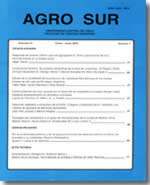Floristic, phytosociological and edaphic changes produced by grazing exclusión in a prairie of Valdivia, Chile
Main Article Content
Abstract
In a farm prairie located 12 km west from San José de la Mariquina village, province of Valdivia (Chile) floristic, phytosociological and edaphic changes produced by grazing exclusion under a 10 years old electric fence are studied. The floristic analysis was made comparing plants lists obtained from partially tables made up by 7 and 11 vegetation samples taken with the phytosociological methods in the prairie and in the exclusion zone, respectively. Plant associations were determined with differential species. The soils comparison was made with physical and chemical analysis and using ecological indicators values. The resulte were analized with statistical multivariate methods of ordination and classification. The exclusion produced an impoverishment of the prairie flora and significative changes in frequency and cover of the species belonging to both conditions: in the grazing prairie dominated Dactylis glomerata, Lolium perenne, Bromus catharticus and Trifolium repens, in the exclusion zone on the other hand, dominated only Agrostis capillaris which is inhibited by grazing. The biological spectra are similar and only the annuals weeds are more abundant in the grazing prairie. Floristic changes in the exclusion zone are so extremely that a different plant association was formed, namely Hyperico-Agrostidetum capillariaeinst ead Bromo-Lolietumperennis of the grazing prairie. The prairie soil was more compactnees and the pH and mineral nutrients are highest. Ecological indicator values differentiated both conditions and characterized the prairie soil as eutrophic and the exclusion zone soil as oligotrophic.

